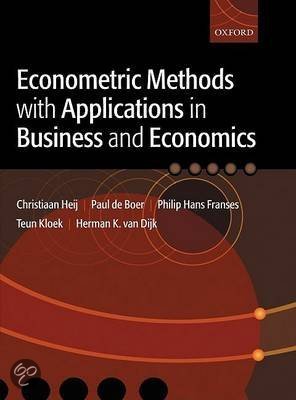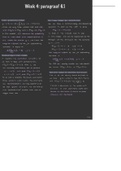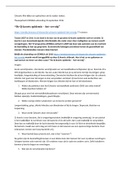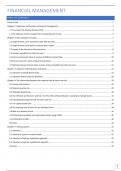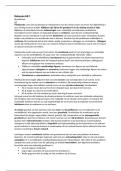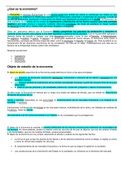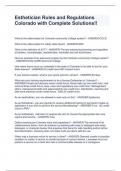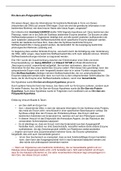Week 4: paragraaf 6.1
Linear probability model non -
linear model for probabilities
h
'
P E E- [ Ei ] tahe monotcnically deoeasing
yi xi -1
Ei =P +
Pjxji + Ei 0 We non
= =
can a -
, ,
g- = 2
which takes Values and function F such the CDF to force
can
only zero are . ,
as
xi
'
P = E- [ yi ] = 0 P[
yi =o ] -11 P [ yi =
] =P [
,
-
=
, ] Ptyi =
, ] =
Flxi '
Ps )
y,
. -
the interval to
In this model
,
✗ ÍP measures the prcbability
to fail in zero are .
'
In this model Xi P can be explained as the
that an individual with character istics ✗i
the Strength of the stimulus for the outccme
wilt make the Choice =\ so that
yi ,
=L with
the i
marginat effect of jth explanatory
,
'
P[ ] s 1 if Xi P ' as
yi
=
,
to
variable is
eqval
]
'
P [ yi = 1 so
if Xi P ) -
J P [ yi ] h
Bj
=
,
j
= = 2 . . .
, , ,
J i The
margin at effect of the jth explanatory
Disaduantages linear model variable is
'
it impos.es the restricties o ←
Xi PEI as
JP [ yi =
]
'
f- ( xi P ) Pj 2 k
g-
, = = _ . _
, , ,
J i
we have to deal with
probabilities ,
The ME smalle for individual s
E- [ ] =P [y ]
'
Also
a re
usually
yi ,
-
=
, =
Xi P .
,
[i are
for which P [ ] to or P [ ] = I
yi y
=
= , ,
-
, .
not normally distributed , but as follows :
'
'
with prob P [ ] P
Ei 1- ✗i
/3 yi Xi
=
=
.
=
,
Restricties needed for parameter Identification
[i = 0 -
xi
'
13 with
prcb .
P [yi =
0 ] =
1- Xi
'
P
The a
of the
density should be fixed .
If
so
Ei has a discrete Bernoulli distribution
have (t) f- Cont ) then G ( t) Flat) ,
.
we
g -
-
= -
,
( Ei ) 13 (
'
P) the terms
'
since Xi
)
Xi
'
er ror
(
i
( xi B)
va r '
P [ yi
=
]
-
, and =
, = F- =
G Xi P .
So
5
are heteroshedastic as
they depesd on P .
F ( Xi 13 )
'
is
equivalent to the model with
'
as OLS ignores OE Xi 13<-1 ,
we can
endup
' ' function G and parameter vector Plo .
with probabilities smaller than ze ro or
Uariance of distribution f- should be fixed ,
trigger than a re .
other Wise not identified .
S. Veeling
ijij
, Interpretation in terms of latent variable
"
margin at effects of explanatcry variable s
IID [ Ei ]
'
Xi P + Ei Ei E-
~
yi
=
, ,
Since the ME depend om ✗i
, they a re
This
'
is the index function ,
with Xi P the
different among individual s . The effects
Systematic prefereren and Ei the individual -
of the jth variable can be svmmarized by
specific effect .
the effects the sample
mean
marginaal over
The obseved Choice is related to the
y
of n individuals
index "
b
y
*
÷
IÈ J P [ yi =
, ] =
pj ÷ È .
1- Lxip ) , j = 1
,
. . .
,
h
yi
= 1 if yi
Zo J i
*
if probabilih.es the Odds ratio
yi
=
o
yi
< 0
Campari Son
of and
The
It is assumed that f- ( Ei ) =
f- ( -
[i ) so that Odds ratio is de fired as
a t
'
P [ ] ( xi p)
§ / [ Ei F
P [ Ei t ] f- (s ) ds f- ( s ) =P < t]
=
,
ds
-
= =
> - = ,
P [ yi )
'
.
-
as
=
o ] 1 -
Flxi P
and the relative prefeence of option I
and then gives
as
compared to option 0 which depends.cn
P[ [ Ei P ] =P [ Ei E Xi P ] Flxi P )
' '
] =P
' ,
yi
=
, 2 -
✗i =
the values of Xi .
with F CDF of Ei .
For the logit model we have F- =
A = et
,
1 + et
model for mutaties
and 1 -
Ilt ) = 1 so that
[ ] Flxi P )
'
et
depend 1 +
P does not only en
= =
yi
,
1 ( t) = et and
the explanatory variable s but also on the
1 ( f)
,
y -
distribution of the unobseved individual
' '
log
1 ( xi 13 ) =
xi P
effects Ei This detemines the Shape ( x: p)
'
.
1 -
1
of the
margin al respons via f- ( Ei ) .
In So in the
logit model the
log
-
odds is
the prcbit Linear of
practica ,
a re choses often a
function Xi .
model with Standard normal density
,
'
maximum likelihood for probit and
logit
It
( t) ¢ ( t) e-
f-
#
= =
If the probability of succes is the same
for an observations so P [ ] =p then
yi
=
,
logistic density
, ,
the model
or
logit with
the probability distribution for the ith
f- ( t )
=
✗ ( t) = et
2
( + et ) " '
Yi
-
observation is
p ( i -
p ) . If observations
that
an
advangtage of the
logit model is
are
mutvally independent ,
then we have
¥
there exist an explicit former latior for " '
Yi
(p )
-
L (i ) and
log likelihood
p
=
p
-
-
,
the CDF
t
( Llp ) ) 2 (p ) 2 log (i p)
| et log
=
log + -
1 ( f) =
✗ ( s ) ds = =
1
{ i : g. }
t
= ,
{ i yio }:
→ 1 + et y + e-
=
È .
yi log (p ) +
È( i -
yi ) log ( 1-
p)
maximizing this gives  = ÷ Ê ,
yi .
S. Veeling
ij ijij
Linear probability model non -
linear model for probabilities
h
'
P E E- [ Ei ] tahe monotcnically deoeasing
yi xi -1
Ei =P +
Pjxji + Ei 0 We non
= =
can a -
, ,
g- = 2
which takes Values and function F such the CDF to force
can
only zero are . ,
as
xi
'
P = E- [ yi ] = 0 P[
yi =o ] -11 P [ yi =
] =P [
,
-
=
, ] Ptyi =
, ] =
Flxi '
Ps )
y,
. -
the interval to
In this model
,
✗ ÍP measures the prcbability
to fail in zero are .
'
In this model Xi P can be explained as the
that an individual with character istics ✗i
the Strength of the stimulus for the outccme
wilt make the Choice =\ so that
yi ,
=L with
the i
marginat effect of jth explanatory
,
'
P[ ] s 1 if Xi P ' as
yi
=
,
to
variable is
eqval
]
'
P [ yi = 1 so
if Xi P ) -
J P [ yi ] h
Bj
=
,
j
= = 2 . . .
, , ,
J i The
margin at effect of the jth explanatory
Disaduantages linear model variable is
'
it impos.es the restricties o ←
Xi PEI as
JP [ yi =
]
'
f- ( xi P ) Pj 2 k
g-
, = = _ . _
, , ,
J i
we have to deal with
probabilities ,
The ME smalle for individual s
E- [ ] =P [y ]
'
Also
a re
usually
yi ,
-
=
, =
Xi P .
,
[i are
for which P [ ] to or P [ ] = I
yi y
=
= , ,
-
, .
not normally distributed , but as follows :
'
'
with prob P [ ] P
Ei 1- ✗i
/3 yi Xi
=
=
.
=
,
Restricties needed for parameter Identification
[i = 0 -
xi
'
13 with
prcb .
P [yi =
0 ] =
1- Xi
'
P
The a
of the
density should be fixed .
If
so
Ei has a discrete Bernoulli distribution
have (t) f- Cont ) then G ( t) Flat) ,
.
we
g -
-
= -
,
( Ei ) 13 (
'
P) the terms
'
since Xi
)
Xi
'
er ror
(
i
( xi B)
va r '
P [ yi
=
]
-
, and =
, = F- =
G Xi P .
So
5
are heteroshedastic as
they depesd on P .
F ( Xi 13 )
'
is
equivalent to the model with
'
as OLS ignores OE Xi 13<-1 ,
we can
endup
' ' function G and parameter vector Plo .
with probabilities smaller than ze ro or
Uariance of distribution f- should be fixed ,
trigger than a re .
other Wise not identified .
S. Veeling
ijij
, Interpretation in terms of latent variable
"
margin at effects of explanatcry variable s
IID [ Ei ]
'
Xi P + Ei Ei E-
~
yi
=
, ,
Since the ME depend om ✗i
, they a re
This
'
is the index function ,
with Xi P the
different among individual s . The effects
Systematic prefereren and Ei the individual -
of the jth variable can be svmmarized by
specific effect .
the effects the sample
mean
marginaal over
The obseved Choice is related to the
y
of n individuals
index "
b
y
*
÷
IÈ J P [ yi =
, ] =
pj ÷ È .
1- Lxip ) , j = 1
,
. . .
,
h
yi
= 1 if yi
Zo J i
*
if probabilih.es the Odds ratio
yi
=
o
yi
< 0
Campari Son
of and
The
It is assumed that f- ( Ei ) =
f- ( -
[i ) so that Odds ratio is de fired as
a t
'
P [ ] ( xi p)
§ / [ Ei F
P [ Ei t ] f- (s ) ds f- ( s ) =P < t]
=
,
ds
-
= =
> - = ,
P [ yi )
'
.
-
as
=
o ] 1 -
Flxi P
and the relative prefeence of option I
and then gives
as
compared to option 0 which depends.cn
P[ [ Ei P ] =P [ Ei E Xi P ] Flxi P )
' '
] =P
' ,
yi
=
, 2 -
✗i =
the values of Xi .
with F CDF of Ei .
For the logit model we have F- =
A = et
,
1 + et
model for mutaties
and 1 -
Ilt ) = 1 so that
[ ] Flxi P )
'
et
depend 1 +
P does not only en
= =
yi
,
1 ( t) = et and
the explanatory variable s but also on the
1 ( f)
,
y -
distribution of the unobseved individual
' '
log
1 ( xi 13 ) =
xi P
effects Ei This detemines the Shape ( x: p)
'
.
1 -
1
of the
margin al respons via f- ( Ei ) .
In So in the
logit model the
log
-
odds is
the prcbit Linear of
practica ,
a re choses often a
function Xi .
model with Standard normal density
,
'
maximum likelihood for probit and
logit
It
( t) ¢ ( t) e-
f-
#
= =
If the probability of succes is the same
for an observations so P [ ] =p then
yi
=
,
logistic density
, ,
the model
or
logit with
the probability distribution for the ith
f- ( t )
=
✗ ( t) = et
2
( + et ) " '
Yi
-
observation is
p ( i -
p ) . If observations
that
an
advangtage of the
logit model is
are
mutvally independent ,
then we have
¥
there exist an explicit former latior for " '
Yi
(p )
-
L (i ) and
log likelihood
p
=
p
-
-
,
the CDF
t
( Llp ) ) 2 (p ) 2 log (i p)
| et log
=
log + -
1 ( f) =
✗ ( s ) ds = =
1
{ i : g. }
t
= ,
{ i yio }:
→ 1 + et y + e-
=
È .
yi log (p ) +
È( i -
yi ) log ( 1-
p)
maximizing this gives  = ÷ Ê ,
yi .
S. Veeling
ij ijij

